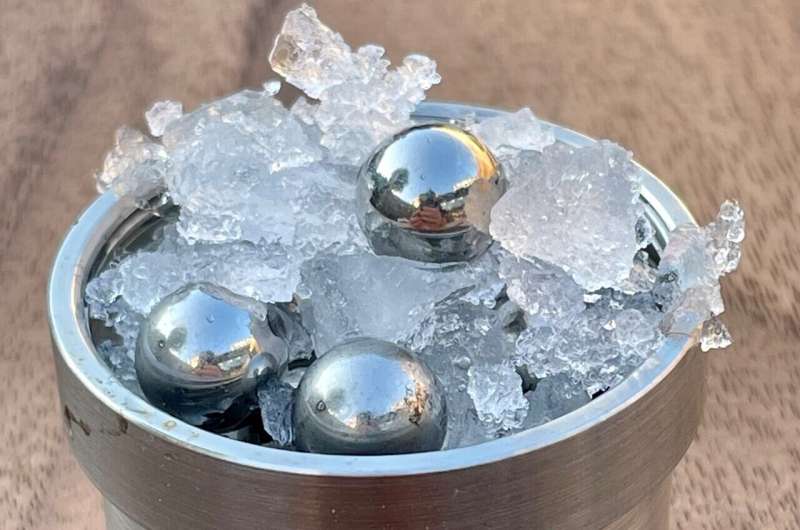Researchers at UCL and the University of Cambridge have discovered a new type of ice that more closely resembles liquid water than any other known ices and that may rewrite our understanding of water and its many anomalies.
The newly discovered ice is amorphous—that is, its molecules are in a disorganized form, not neatly ordered as they are in ordinary, crystalline ice. Amorphous ice, although rare on Earth, is the main type of ice found in space. That is because in the colder environment of space, ice does not have enough thermal energy to form crystals.
For the study, published in the journal Science, the research team used a process called ball milling, vigorously shaking ordinary ice together with steel balls in a jar cooled to -200 degrees Centigrade.
They found that, rather than ending up with small bits of ordinary ice, the process yielded a novel amorphous form of ice that, unlike all other known ices, had the same density as liquid water and whose state resembled water in solid form. They named the new ice “medium-density amorphous ice” (MDA).
The team suggested that MDA (which looks like a fine white powder) may exist inside ice moons of the outer solar system, as tidal forces from gas giants such as Jupiter and Saturn may exert similar shear forces on ordinary ice as those created by ball milling. In addition, the team found that when MDA was warmed up and recrystallized, it released an extraordinary amount of heat, meaning it could trigger tectonic motions and “icequakes” in the kilometers-thick covering of ice on moons such as Ganymede.
Senior author Professor Christoph Salzmann (UCL Chemistry) said, “Water is the foundation of all life. Our existence depends on it, we launch space missions searching for it, yet from a scientific point of view it is poorly understood.
“We know of 20 crystalline forms of ice, but only two main types of amorphous ice have previously been discovered, known as high-density and low-density amorphous ices. There is a huge density gap between them and the accepted wisdom has been that no ice exists within that density gap. Our study shows that the density of MDA is precisely within this density gap and this finding may have far-reaching consequences for our understanding of liquid water and its many anomalies.”
The density gap between the known amorphous ices has led scientists to suggest water in fact exists as two liquids at very cold temperatures and that theoretically, at a certain temperature, both of these liquids could co-exist, with one type floating above the other, as when mixing oil and water. This hypothesis has been demonstrated in a computer simulation, but not confirmed by experiment. The researchers say that their new study may raise questions about the validity of this idea.
Professor Salzmann said, “Existing models of water should be re-tested. They need to be able to explain the existence of medium-density amorphous ice. This could be the starting point for finally explaining liquid water.”
The researchers proposed that the newly discovered ice may be the true glassy state of liquid water—that is, a precise replica of liquid water in solid form, in the same way that glass in windows is the solid form of liquid silicon dioxide. However, another scenario is that MDA is not glassy at all, but is in a heavily sheared crystalline state.





